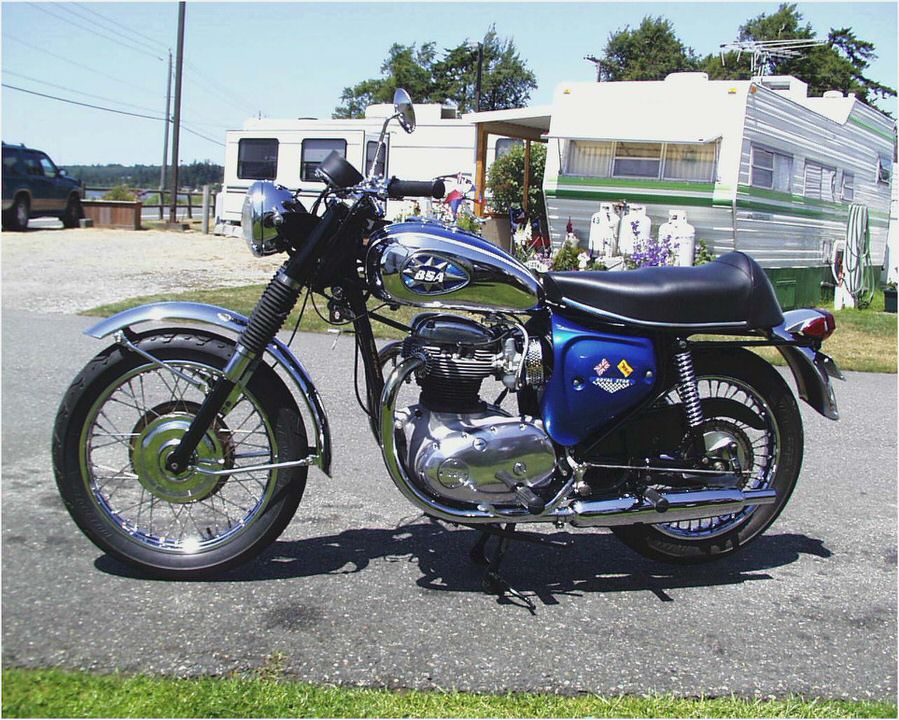
BSA DBD34 Gold Star
1956 BSA DBD34 Gold Star Specifications
Type: Air-cooled OHV single
Capacity: 499cc (500cc)
Bore Stroke: 85mm x 88mm
BHP: 42 @ 7000rpm
Compression ratio: 8.75:1
Transmission: 4-speed, multi-plate
wet clutch
Top BSA DBD34 Gold Star specialists and links
WHEN THE DBD34 CLUBMAN GOLD STAR was launched in 1956, BSA must have known even then that the bike was nearing the end of its reign, both commercially and technically speaking. The company had, after all, done just about everything to its Gold Star predecessors that it was possible to do. And in this, its final incarnation, it had become so highly strung that you needed to be a violinist to play it.
Which, naturally, didn’t stop a lot of ordinary less-musical guys from trying; guys who knew that when these temperamental, uncompromising, two-wheeled, testosterone hot-rods were on song, there was little else on the street, track or dirt to touch them.
With its race proven pedigree and that legendary Gold Star exhaust ‘twitter’, the 110mph, 384lb DBD34 was to motorcycling what Arnold Schwarzenegger is to politics.
Meaning lean, mean, brash and loud.
Gold Star magnetos It was a superlative machine that, ultimately, was to become something of a victim of its own success. Which was why by 1963 it was deemed too expensive (and time-consuming) to build, too anti-social too countenance, too hot to handle—and generally out of step with the current vogue for twins and lightweights, which was where BSA saw its industrial future. Moreover, for all its improvements it was becoming less and less competitive0 against the Triumphs and Nortons of the day.
Additionally, it’s often said that the Gold Star was scrapped largely because Lucas stopped producing magnetos—which sounds an unlikely excuse in view of the other ignition options available at the time. More likely, BSA simply recognised that it was chasing a diminishing share of a shrinking market and took the quick exit when Joe Lucas held open a convenient door.
Either way, the Goldie was scrapped and shunted aside in favour of the new ‘C’ series lightweight kids on the block. And because, like Elvis, it died a sudden death before it had outgrown its appeal, its classic status was. well, enshrined in gold.
Nowadays, the fortunes of this ‘classic street hooligan’— following a few years in the doldrums—are climbing again. The wheel of fashion has gone full circle, and big money appears to be changing hands for genuine—and sometimes fake—machines. But the Gold Star market had been a curiously volatile one, so take care not to mistake a blip for a trend.
If you’re seriously thinking of buying one, take a tip and get yourself a health check before you book that test ride (notably around the left wrist and the right ankle, and pretty much everything in between). Because ownership of a DBD34 Gold Star, with all its quirks and foibles, is nothing if not a challenging experience.
BSA BB, CB, and ZB Gold Stars
BSA had lit the Gold Star fuse as far back as 1937 when Wal Handley lapped the famous Brooklands race track in Surrey at over 100mph. He was riding an M23 Empire Star. BSA, quick to capitalise on that achievement, hurriedly released an M24 Gold Star.
The engines of these early Goldie were heavily worked over; a time-consuming and therefore expensive process which included polished ports, conrod and crankcases. Then the motors were dyno tested and certified as being not merely warm but hot.
Riders of the day quickly seized the opportunity that BSA had presented and began campaigning Goldies—with great success.
And then the war.
Post hostilities, BSA produced a B31 348cc single
(1945), a B32 350cc single primarily for the trials market (1946), a B33 500cc for sidecar and touring (1947), and another competition model, the B34 (1947).
In 1949, the (348cc) B32 became available as a B32GS, GS for Gold Star; a package that included an alloy top-end. The same year, the B34 got the Gold Star treatment.
The aforementioned (348cc) B32 Gold Star soon became referred to as the ZB type, which in turn prompted a more musclebound stablemate; the ZB34 Goldie (499cc).
These bikes, note, were still being built around plunger frames. But that changed in 1953 when the swinging arm models made their first appearance. This was the arrival of the BB Gold Stars.
In 1954, the big-finned Goldies, known as the CB models, arrived on the scene, and the DB upgrade appeared in 1955.
DBD34 Goldies
Complicated? You bet. With all the changes and options, it’s a wonder any potential customer could stay awake long enough to make up his or her mind as which bike to buy.
Regardless, the 350 and 500 Gold Stars (of all types) had been knocking ‘out most of the competition—even in the hands of average clubman racers—and looked set to continue for some time to come.
A wide range of camshafts, gearsets, compression ratios, exhausts and other components gave these awesome BSAs a distinct competition edge and refined the package to the nth degree. Which meant that by the time the (final) 1956 DBD34 appeared on the drawing board (which, incidentally, dominated the Clubman TT of that same year), there wasn’t much about the fundamental architecture the company didn’t understand. What prevented further development beyond the DBD envelope was nothing other than commercial expediency underpinned by, amongst other things, the law of diminishing returns.
At the heart of the beast was an all-aluminium, single-cylinder 39bhp-42bhp, OHV, timebomb. Two valves, two pushrods and one heavily breathed on high compression (8.75:1) piston were all that was needed to propel this bike from zero revolutions to around 7000rpm—with maximum power coming in at 6500rpm (figures from Phil Pearson). But remember: Each bike is different, which means that they’ll dial in different numbers with a potential detonation point at varying positions on the rev counter.
With an 85mm bore and an 88mm stroke, the next key ingredient—some would argue the main ingredient—in this fantastic motorcycling adventure was the massive 1-1/2-inch Amal GP carburettor which sucked fuel like a 747 and spat the burnt mixture through the now legendary Gold Star megaphone.
RRT2 gearbox
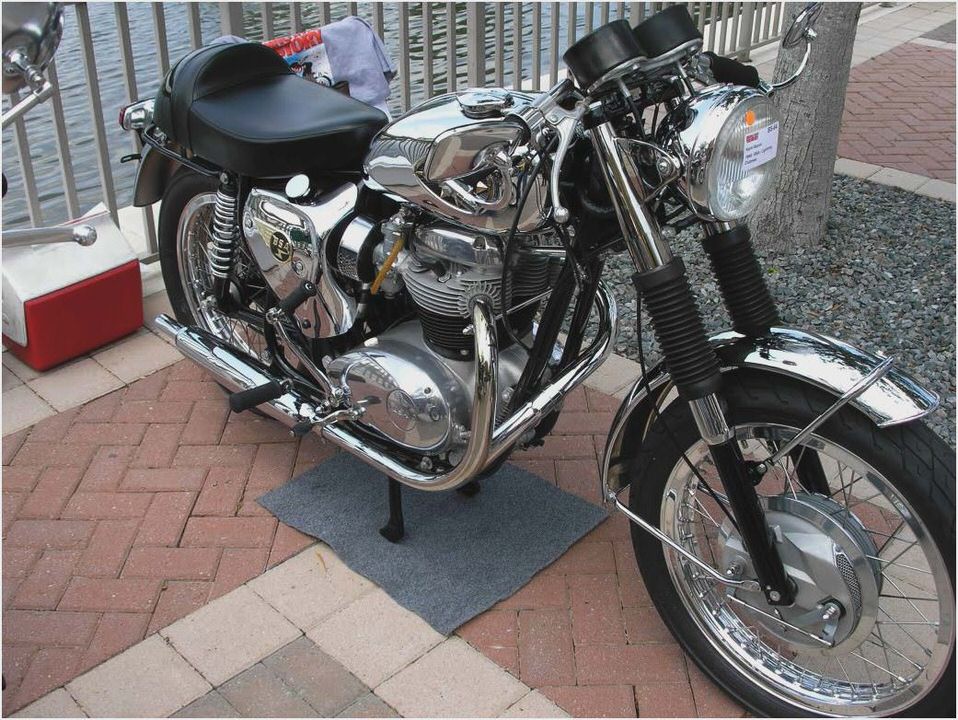
The cylinder head, based upon its ‘CB’ Gold Star predecessor—and which had been revised for the DBD to accommodate one of the largest carburettors in the business—now featured shallower valve angles and a slightly larger inlet valve.
During that first season the inlet tract would be reduced to 1-7/16 inches to provide a small ‘turbulence lip’ which was claimed to improve performance.
Along with the DBD package came the ultra-close ratio RRT2 gearbox; RR for ultra-close ratio; T for Torrington needle-roller bearings; and a 2 because needle roller sets were fitted in both the sleeve gear, and at either end of the layshaft. The clutch (and later the drive chains) was also beefed up to handle the extra horses.
Cradling all this good, manly fun was what was essentially a stock (and for some riders a slightly humiliating) all-welded B33 frame, albeit one with revised lugs and brackets, and, of course, the hallowed GS number identification codes.
The front suspension was handled by BSA’s competent—but unremarkable—single-damped fork, while at the rear, a pair of Girling dampers smoothed the bumps from a competent enough swinging arm. And to keep this under control, this year’s Goldie also saw the introduction of the optional 190mm (7-1/2 inch) full width front brake offering increased friction area over the stock 8-inch single-sided item.
With its clip-on handlebars, swept back exhaust, quickly detachable silencer and easily removed electrical equipment (for competition purposes), the DBD34 was the perfect tool for the Clubman racing class—and, for a brief while, it even managed to keep the ever power-hungry Yanks tolerably quiet.
But none of this would be worth the Ј270 asking price (in 1956) had the engine, as with all Gold Stars, not been meticulously assembled by time served engineers from hand chosen-components and rigorously bench tested before delivery.
Factory options included alloy wheel rims, an aluminium tank, a choice of compression ratios, and an Amal monobloc carburettor. It would have been cheap at double the price.
BSA DBD34 Gold Star buyer/ownership tips
1. Check the engine numbers and provenance meticulously. Fakes are common.
2. Check exactly what you’re buying. Genuine Gold Stars are occasionally (and deliberately) sold minus period perfect parts including the gearbox and carburettor. You’re well advised to photograph the offered bike and check with the Gold Star club.
3. Confusion abounds regarding the various BB Gold Stars, CB Gold Stars and DB models. If you’re seriously looking for a Gold Star, study meticulously. It can make thousands of pounds of difference.
5. If you’re planning to use your Gold Star for general street use, opt for one of the milder tuned models; perhaps a 350cc bike. The top-of-the-range, highly-tuned 500cc DBDs are tiresome in the extreme and, poseability aside, are just not convenient machines for daily use. Most won’t tickover and are lumpy as hell below 3000rpm.
There’s a lot to be said in favour of a genuine and honest B31 or B33 Gold Star lookalike, of which there are quite a few around.
6. The Gold Star uses a peelable foil head gasket. Fitting it has to be very precisely done and can quickly blow if the job isn’t handled properly. So when buying, look for black stains around the joint, especially if the compression feels less than it should.
7. Check that the magdyno is secure. These are held in place by a single strap.
8. Gold Stars are frequently started on the centre stand. That stresses the lugs and bolts. So check for a smooth action, and look for obvious damage.
9. An SRM alternator conversion is a useful upgrade is you’re planning a lot of touring.
10. Gold Stars were never supplied with Akront wheel rims. Nothing wrong with them, but Borrani and Dunlop rims are the real McCoy.
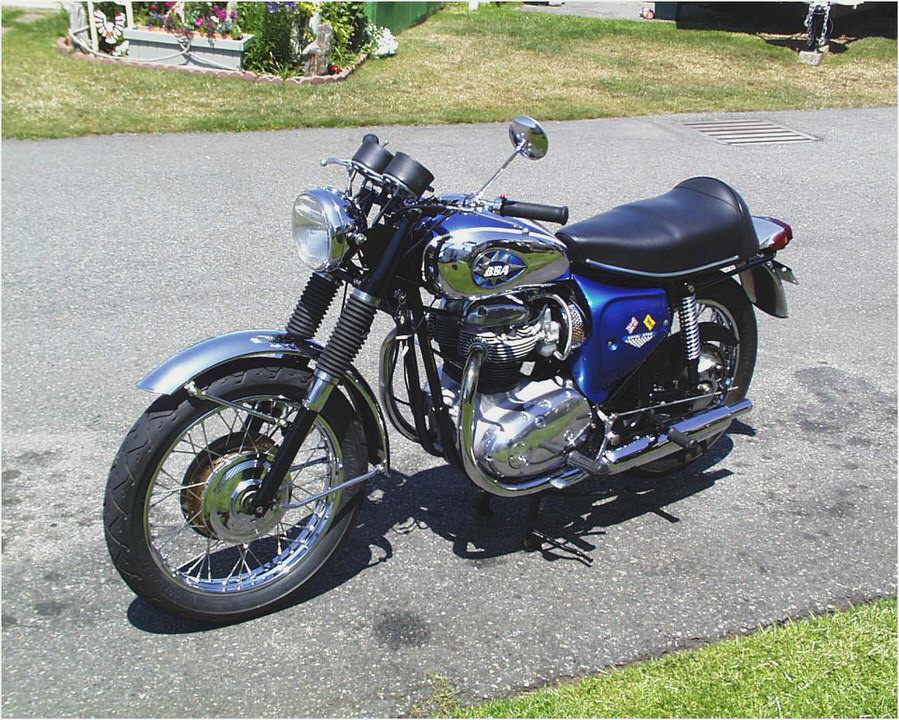
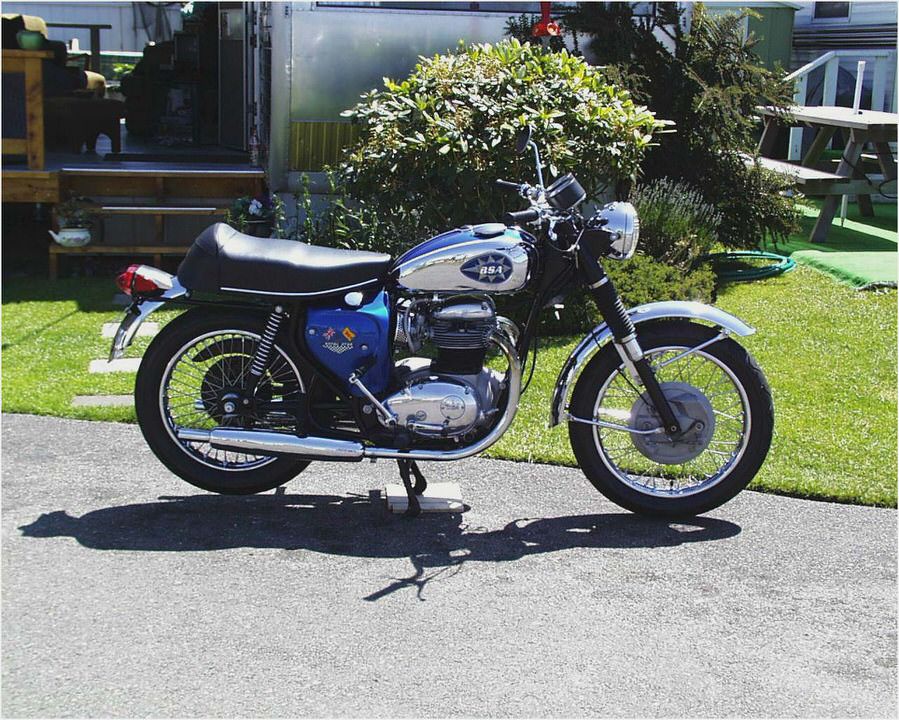

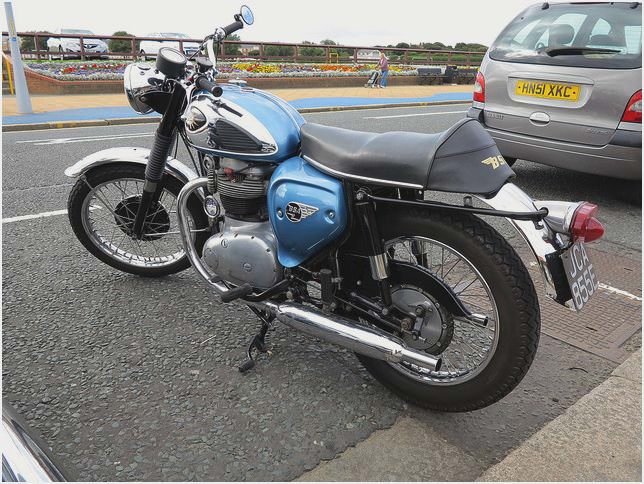
- How to Identify BSA Frames eHow
- Triples Online – For Sale / Wanted
- Memorable Motorcycle BSA B.40 350 – Motorcycle USA
- 1962 BSA A65
- BSA A65 The MotoWorld Blog

